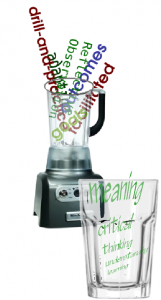 Source: User Generated Education
Source: User Generated EducationIn order to approach learning situations as problems to be solved, rather than topics to be discussed, I’d like to start by defining what, in my view, makes a learning situation “thick.” I’m appropriating the word and concept from Clifford Geertz and the discipline of ethnography, and I’ll attempt to apply it as a lens or framing for teaching and learning, which are, as we know, always socially situated.
From Instruction to Learning
For her chapter entitled Reviewing the trajectories of e-learning [which I summarized on this blog, tweeted, shared on social media, and shared again in my workplace] Gráinne Conole chose the word “trajectory” — a clear link to rocket travel! In keeping with her metaphor, by all indications eLearning has achieved escape velocity and settled into orbit. It certainly shows no signs of falling back to earth any time soon.
…when educators consider the people, places, ideas, and things that might empower the learner or enhance delivery and retention of the content. What technology will I make available to my learners? What have others already prepared that can assist me in explaining things better? Where can I take my learners, both physically and via the web? Can we build something together, plan for synchronicity and serendipity—consider the human chemistry that we are about to incubate? Which experts will I invite to participate? How can we draw out the expertise that may already exist amongst participants we’ve yet to meet?
Conole highlighted what she seems to see as an evolutionary development that’s taking place, from “instructional design” to “learning design.” One concrete way I see this taking shape happens when educators consider the people, places, ideas, and things that might empower the learner or enhance delivery and retention of the content. What technology will I make available to my learners? What have others already prepared that can assist me in explaining things better? Where can I take my learners, both physically and via the web? Can we build something together, plan for synchronicity and serendipity—consider the human chemistry that we are about to incubate? Which experts will I invite to participate? How can we draw out the expertise that may already exist amongst participants we’ve yet to meet?
Storytelling: a catalytic convertor for learning situations
It is becoming increasingly clear that personal and other illustrative stories, dilemmas, scenarios, etc. can act as a “catalyst” that motivates learners to relate to the content. In the language (affectionately?) known as edubabble it might sound like, “foster intrinsic motivation…, enable learner agency…,” or “to construct meaningful knowledge.” I surmise that this might be an added benefit if the educator aspires to create a situation that is memorable and transformational, rather than simply informational.
A situation leading to an inquiry
Supposing you were teaching middle school children civics, and how legislation is created. You might want to talk about “precedent,” and how laws are made or changed—laws we all have to obey. What if you took a piece of case law on a subject you feel your learners may find relevant, and that a legal expert available to your classroom community has told you helped set precedent? What if you engaged those experts and others to present the case to this class as a story, framed in language of fairness and conflict resolution?
Add thickener
So far we’ve not done much out of the ordinary. We could just give a quiz and call it a day. But I believe, and I’ll bet you do too, that that would be a very superficial assessment of some very superficial learning. Instead, what if we ask, “Has anything like this ever happened to you? Do you agree with the outcomes? Who benefits from this law? How?”
I’m interested in hearing from teachers, counselors, and educators of all sorts whether they have tried such an approach, would be willing to try such an approach, or even whether it’s a good idea. Would you care to leave a comment?
§
More links
Schwartz, Susan and Bone, Maxine (1995), Retelling, Relating, Reflecting — Beyond the 3 Rs, a book that does critical thinking with kids exceptionally well.
Digital Storytelling Toronto
Stories for Change
Knowledge-building community model




